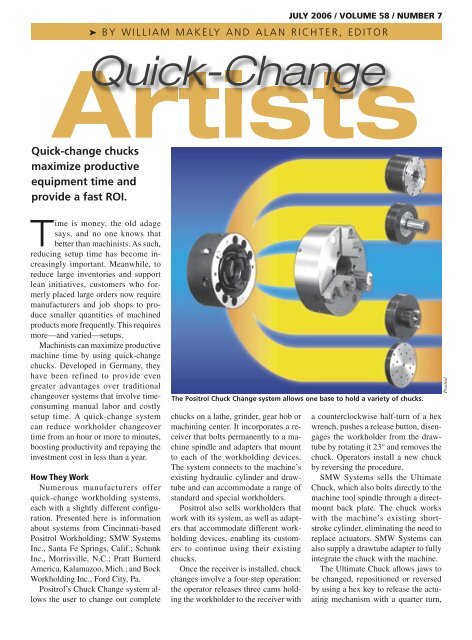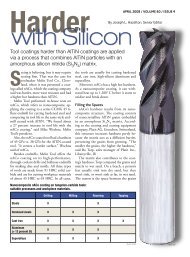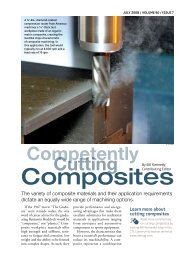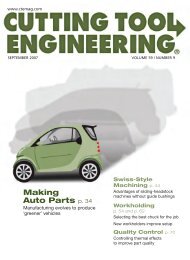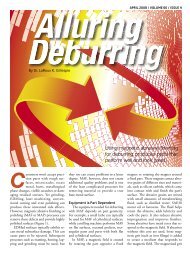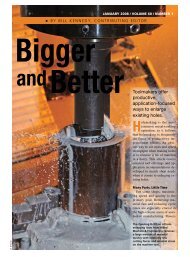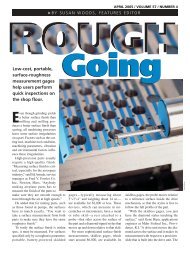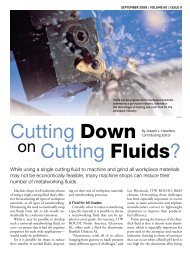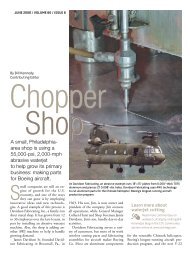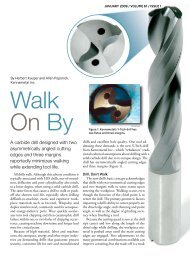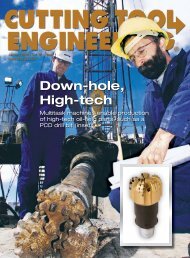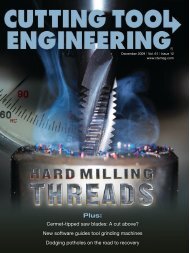Quick-Change - Cutting Tool Engineering
Quick-Change - Cutting Tool Engineering
Quick-Change - Cutting Tool Engineering
You also want an ePaper? Increase the reach of your titles
YUMPU automatically turns print PDFs into web optimized ePapers that Google loves.
➤ B Y W I L L I A M M A K E LY A N D A L A N R I C H T E R , E D I T O R<br />
Artists<br />
<strong>Quick</strong>-change chucks<br />
maximize productive<br />
equipment time and<br />
provide a fast ROI.<br />
<strong>Quick</strong>-<strong>Change</strong><br />
Time is money, the old adage<br />
says, and no one knows that<br />
better than machinists. As such,<br />
reducing setup time has become increasingly<br />
important. Meanwhile, to<br />
reduce large inventories and support<br />
lean initiatives, customers who formerly<br />
placed large orders now require<br />
manufacturers and job shops to produce<br />
smaller quantities of machined<br />
products more frequently. This requires<br />
more—and varied—setups.<br />
Machinists can maximize productive<br />
machine time by using quick-change<br />
chucks. Developed in Germany, they<br />
have been refined to provide even<br />
greater advantages over traditional<br />
changeover systems that involve timeconsuming<br />
manual labor and costly<br />
setup time. A quick-change system<br />
can reduce workholder changeover<br />
time from an hour or more to minutes,<br />
boosting productivity and repaying the<br />
investment cost in less than a year.<br />
How They Work<br />
Numerous manufacturers offer<br />
quick-change workholding systems,<br />
each with a slightly different configuration.<br />
Presented here is information<br />
about systems from Cincinnati-based<br />
Positrol Workholding; SMW Systems<br />
Inc., Santa Fe Springs, Calif.; Schunk<br />
Inc., Morrisville, N.C.; Pratt Burnerd<br />
America, Kalamazoo, Mich.; and Bock<br />
Workholding Inc., Ford City, Pa.<br />
Positrol’s Chuck <strong>Change</strong> system allows<br />
the user to change out complete<br />
chucks on a lathe, grinder, gear hob or<br />
machining center. It incorporates a receiver<br />
that bolts permanently to a machine<br />
spindle and adapters that mount<br />
to each of the workholding devices.<br />
The system connects to the machine’s<br />
existing hydraulic cylinder and drawtube<br />
and can accommodate a range of<br />
standard and special workholders.<br />
Positrol also sells workholders that<br />
work with its system, as well as adapters<br />
that accommodate different workholding<br />
devices, enabling its customers<br />
to continue using their existing<br />
chucks.<br />
Once the receiver is installed, chuck<br />
changes involve a four-step operation:<br />
the operator releases three cams holding<br />
the workholder to the receiver with<br />
JULY 2006 / VOLUME 58 / NUMBER 7<br />
The Positrol Chuck <strong>Change</strong> system allows one base to hold a variety of chucks.<br />
a counterclockwise half-turn of a hex<br />
wrench, pushes a release button, disengages<br />
the workholder from the drawtube<br />
by rotating it 23° and removes the<br />
chuck. Operators install a new chuck<br />
by reversing the procedure.<br />
SMW Systems sells the Ultimate<br />
Chuck, which also bolts directly to the<br />
machine tool spindle through a directmount<br />
back plate. The chuck works<br />
with the machine’s existing shortstroke<br />
cylinder, eliminating the need to<br />
replace actuators. SMW Systems can<br />
also supply a drawtube adapter to fully<br />
integrate the chuck with the machine.<br />
The Ultimate Chuck allows jaws to<br />
be changed, repositioned or reversed<br />
by using a hex key to release the actuating<br />
mechanism with a quarter turn,<br />
Positrol
emoving or repositioning the jaw, then<br />
re-engaging the actuator using the key.<br />
Wedge Design<br />
Although practically all quickchange<br />
systems incorporate a wedgebar<br />
chuck, Schunk’s wedge system<br />
on the THW-plus quick-change-jaw<br />
lathe chuck drops straight down. This<br />
prevents chips and other contaminants<br />
from entering into the chuck body’s<br />
pocket and causing repeatability problems<br />
and premature wear.<br />
Steve Hartung, Schunk’s product<br />
manager for rotating workholding,<br />
explained: “With our system, you only<br />
have to turn a wrench 90° to remove<br />
one set of jaws, as opposed to our competitors’<br />
[products] where you have to<br />
turn the wrench, say, 180° or better.<br />
What that does is slide the wedge all<br />
the way over. When it does that, it<br />
exposes the chuck body and anything<br />
that’s sitting there will dump down<br />
The following companies<br />
contributed to this report:<br />
Bock Workholding Inc.<br />
(877) 426-2504<br />
www.bockworkholding.com<br />
The Charles Machine Works Inc.<br />
(800) 654-6481<br />
www.ditchwitch.com<br />
Positrol Workholding<br />
(513) 272-0500<br />
www.positrol.com<br />
Pratt Burnerd America<br />
(800) 253-0820<br />
www.prattburnerd.com<br />
Schunk Inc.<br />
(919) 572-2705<br />
www.schunk-usa.com<br />
SMW Systems Inc.<br />
(800) 423-4651<br />
www.smwsystems.com<br />
inside the chuck body.”<br />
End users need to grease all chucks<br />
for them to perform properly, but it’s<br />
even more important with a wedge-bar<br />
chuck, which has more moving parts<br />
than other types of chucks.<br />
To enhance grease retention, Schunk<br />
etches microgrooves into the internal<br />
moving components, such as the piston<br />
and wedge. “Grease retention is<br />
extremely important when you have<br />
chucks, especially wedge-bar chucks,<br />
that need to repeat very well in today’s<br />
tight-tolerance environment,” he said.<br />
One company offers an alternative<br />
to the wedge-bar design, which is typically<br />
not counterbalanced. Pratt Burnerd<br />
America’s lever-wedge design is<br />
counterbalanced, so jaw force is maintained<br />
at high spindle speeds rather<br />
than being lost due to centrifugal force.<br />
“It’s a counter-centrifugal chuck,” said<br />
B.J. Lillibridge, vice president of the<br />
power chuck manufacturer. “Our 8"<br />
chuck is rated at 5,500 rpm and we<br />
rate it at 90 percent jaw retention, or<br />
only 10 percent loss at 5,500 rpm with<br />
a standard-weight jaw.”<br />
To allow machining at the maximum<br />
available speed, Lillibridge noted<br />
that other chuck manufacturers use<br />
a smaller, lighter-weight master jaw<br />
and top jaw to reduce the weight and<br />
mass of the jaws. This decreases the<br />
loss of jaw force at higher speeds. “The<br />
disadvantage of that is if the customer<br />
has, say, standard top tooling with<br />
1.5mm × 60 serrations, he cannot use<br />
those top jaws from his old chuck<br />
and put them on that quick-changejaw<br />
chuck,” he said. “They won’t fit.<br />
Our chuck has larger master jaws, so<br />
we can use those jaws. Because it’s a<br />
counterbalanced chuck, he can use his<br />
existing top tooling.”<br />
In addition to quick-change-jaw systems<br />
for lathes, systems are available<br />
for vertical machining centers such<br />
as the one from Bock Workholding<br />
Inc., Ford City, Pa. The product has a<br />
locater plate, with a standardized grid<br />
pattern that bolts to the top of the ma-<br />
SMW Systems<br />
chine table. An expanding dowel pin<br />
drops through the fixture, vise or other<br />
workholding device into the locating<br />
plate, “and that gives you ±0.001"<br />
repeatability,” said Joseph Cousins,<br />
president of Bock.<br />
He noted that switching from one vise<br />
to another takes about 10 minutes, but<br />
the system has two quick-change capabilities.<br />
“The main system that goes on<br />
the table allows you to change the entire<br />
vise or fixture,” Cousins said, “and the<br />
A quarter-turn of the hex key lets these<br />
jaws from SMW Systems adjust to any<br />
position.<br />
vise itself has a quick-change feature. It<br />
allows you to change machinable jaws<br />
very rapidly—a few seconds.”<br />
Faster, Safer, More Versatile<br />
With quick-change chucks, the time<br />
savings is significant, but that is not the<br />
only benefit.<br />
“With a quick chuck change,” said<br />
Eric Weber, Positrol sales manager,<br />
“a machine runs more efficiently<br />
because it can quickly switch to the<br />
right chuck for the job, and proper<br />
workholding enables machines to run<br />
faster, completing jobs more quickly.<br />
Machines are also better utilized because<br />
they can run a number of different<br />
operations, changing from a 3-jaw<br />
chuck to a collet chuck for running bar<br />
stock, allowing more effective work<br />
scheduling. One machine can run any<br />
part at any given time.”<br />
Steve Brown, vice president of<br />
operations at SMW Systems, echoed<br />
that thought. That’s because the Ultimate<br />
Chuck, rather than enabling<br />
users to change chucks, allows them to<br />
quickly change from hard to soft jaws,<br />
which can be reused without boring.<br />
This increases efficiency. With the system,<br />
they can also switch to a selection<br />
of specialty jaws designed to hold a<br />
variety of workpieces, including round<br />
and nonround bar stock.<br />
“The Ultimate Chuck has a very<br />
long jaw stroke, typically double that<br />
of a standard power chuck,” he pointed<br />
out. “This is quite helpful, especially<br />
for the first-operation chucking on<br />
rough diameters.”<br />
Additionally, the Ultimate Chuck<br />
lets the user quickly adjust the jaws<br />
radially, which allows a single set of<br />
jaws to grip a wide range of diameters.<br />
“Some quick-change-jaw chuck designs<br />
attach the jaw in a single diameter<br />
position only,” Brown said. “With<br />
those, a different set of jaws is required<br />
for every diameter you want to grip—a<br />
costly disadvantage.”<br />
Many companies emphasize the<br />
safety aspects of these systems, because<br />
switching to the right workholding<br />
setup for a job, as opposed to<br />
“making it work” using the workholding<br />
already set up on a machine, makes<br />
for safer operation.<br />
“If the jaw is not seated correctly and<br />
you crank that machine up and create a<br />
high centrifugal force, that jaw could<br />
come out of the chuck and cause damage<br />
to your machine or—worst-case<br />
scenario—the operator,” said Schunk’s<br />
Hartung.<br />
Generally, systems have special<br />
safety features. For example, SMW Systems’<br />
Ultimate Chuck prevents the hex<br />
key from being removed from the chuck<br />
until it is properly locked in place.<br />
Savings and Flexibility<br />
The Charles Machine Works Inc.,<br />
Perry, Okla., reaped multiple benefits<br />
when it switched to quick-change-jaw<br />
chucks from Pratt Burnerd. In addition<br />
to reducing setup time by at least<br />
60 percent, the maker of Ditch Witch<br />
construction equipment was able to<br />
utilize existing top tooling with its 30<br />
systems.<br />
“We’ve got several 15" chuck<br />
machines and four different sets of<br />
master jaws with different serrations<br />
for each machine,” said Jack Galfetti,<br />
the company’s capital-equipment<br />
buyer for manufacturing process<br />
engineering. “They can all share tooling<br />
of different serrations on the back<br />
of the chuck jaws, and you can just<br />
move them around from one place to<br />
another. It makes your facility as flexible<br />
as possible.”<br />
To change a master jaw, the operator<br />
needs only an Allen wrench. Each jaw<br />
has an Allen screw located around the<br />
circumference of the chuck, and to release<br />
a jaw, the Allen wrench is turned<br />
180°. Then, the operator removes the<br />
jaw, puts in a new jaw with the top<br />
tooling already in place and secures it.<br />
“It takes 2 to 3 minutes,” Galfetti said,<br />
“because the jaws should be cleaned<br />
and regreased before they are put back<br />
into the chuck.”<br />
The equipment manufacturer is<br />
working on a 24" chuck project. The<br />
chuck will come with special sets of<br />
master jaws, allowing utilization of its<br />
18" top tooling as well. “We have 239<br />
sets of jaws at $440 a set that we will be<br />
able to reuse,” Galfetti noted.<br />
CUTTING TOOL ENGINEERING Magazine is protected under U.S. and international copyright laws. Before reproducing anything from this Web site, call the Copyright Clearance Center Inc. at (978) 750-8400.<br />
Pratt Burnerd<br />
Pratt Burnerd’s quickchange<br />
master jaw design<br />
allows an end user to<br />
utilize his existing top<br />
tooling regardless of the<br />
type of serration.<br />
And, because of the<br />
chuck’s counterbalance<br />
feature, the manufacturer<br />
didn’t have to worry<br />
about its primarily mildsteel<br />
parts coming loose<br />
during machining. “You<br />
don’t lose grip force as<br />
the machine’s rpm goes<br />
up,” Galfetti said.<br />
Acceptance<br />
<strong>Quick</strong>-change chucking systems<br />
have been relatively popular with<br />
larger manufacturing customers. Job<br />
shops are a harder sell.<br />
“For one thing, the new CNC [machine]<br />
the shop has just bought comes<br />
with a standard chuck, and convincing<br />
the owner to pay another $7,500-plus<br />
for a quick-change chuck is hard to<br />
do,” said SMW Systems’ Brown. “It’s<br />
his money, and though he will gain the<br />
most, he also has to bite the bullet and<br />
pay up front.”<br />
But both Brown and Positrol’s Weber<br />
agree that once a customer has used a<br />
quick-change chuck, the system quickly<br />
proves its value; customers often choose<br />
to have their other machines retrofitted<br />
to gain even more advantage.<br />
Ironically, it is the job shop, with its<br />
multiple smaller jobs requiring multiple<br />
changeovers, that benefits most<br />
from quick-change chuck technology,<br />
but which might be locked into more<br />
conventional thinking when it comes<br />
to workholding. “At most job shops, it<br />
hasn’t really sunk in yet,” said Bock’s<br />
Cousins. “They need to convert from<br />
one job to another very quickly.” q<br />
About the Coauthor<br />
William Makely is a freelance writer<br />
specializing in technical and manufacturing<br />
subjects.


